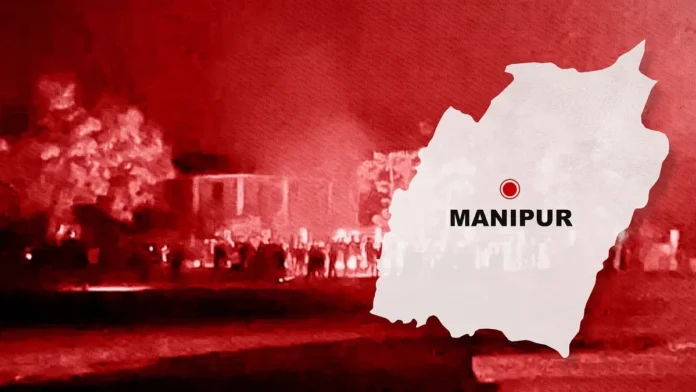IMPHAL, Dec 20: The ongoing ethnic conflict in India’s northeastern state of Manipur has taken a violent turn, as militants who had taken refuge in Myanmar have begun streaming back across the border this year. Indian security officials have reported that the return of these battle-hardened militants, equipped with sophisticated weapons, has exacerbated the 19-month-old conflict between Manipur’s dominant Meitei community and the primarily Christian Kuki tribes.
This escalation has claimed at least 260 lives since May 2023, with over 60,000 people displaced, making it one of the most significant law-and-order failures of Prime Minister Narendra Modi’s government.
Nine Indian military and police officers who spoke to Reuters, plus several politicians and rebel sources in Myanmar, described a conflict that is spreading to new areas as militants from the rival groups come across the border to Manipur.
The violence, which has now spread to new areas of the state, is increasingly fueled by weapons and fighters crossing from Myanmar, as both sides of the conflict see their insurgent groups strengthening. Fighters on both sides have been reported to possess rocket launchers, machine guns, and sniper rifles, with 20 people killed in November alone. In response to the mounting violence, the Indian government announced the deployment of an additional 10,000 soldiers to Manipur, bringing the total to nearly 67,000 troops, in addition to a 30,000-strong police force.
Amid the rising conflict, authorities have observed a surge in organized crime, including extortion and the illegal drug trade, as militant factions fund their operations. According to security officers and military sources, weapons smuggling and illicit drug trade are key funding sources for the insurgents’ activities.
Yumnam Joykumar Singh, former police chief of Manipur and deputy chief minister between 2017 and 2020, highlighted that insurgents who had been subdued a decade ago are once again gaining strength. “Some of them are coming back from Myanmar, some have already come,” Singh said, referencing the return of militants who had previously fled to Myanmar following military crackdowns.
The roots of the current conflict trace back to a May 2023 court order that proposed extending government benefits to the Meitei community, which resides in the prosperous Imphal valley, in a move to align their benefits with those of the Kuki tribes who inhabit the more impoverished hills. This sparked violent clashes between the two groups, despite efforts by security forces to maintain a buffer zone.
The ongoing violence is also connected to insurgencies in Myanmar, with different groups on rival sides of the conflict. Security officers reported that Meitei insurgent groups have been fighting on the side of Myanmar’s ruling junta, with an estimated 2,000 of their cadres stationed in Myanmar’s Sagaing region, just across the border from Manipur. These Meitei groups have fought against anti-junta rebels, including the People’s Defence Force (PDF-K) and the Kuki National Army-Burma (KNA-B), operating in northern Myanmar’s Sagaing, Kachin, and Chin regions.
Meanwhile, the Kuki insurgents have received support from Kachin rebels in Myanmar and have reportedly purchased weapons from Myanmar’s semi-autonomous Wa state. Some Meitei insurgents, who had operated in Myanmar’s border regions with military backing, are now returning to the Manipur frontier, adding fuel to the ongoing conflict.
Indian military and police officers remain uncertain about the precise number of militants crossing the border, but records show that more than 300 insurgents, including both Meitei and Kuki fighters, have been arrested in Manipur in the past two years. This influx of weapons and militants has contributed to a significant shift in the security landscape of the region.
As tensions mount, the Indian government has taken further steps to secure the porous 1,600 km (995-mile) border with Myanmar. A border fence has been planned as part of a larger effort to curb the flow of insurgents and illicit arms into Manipur.
The weapons being used in the ongoing conflict have become increasingly sophisticated. Many of the weapons seized by authorities were looted from state armories in the conflict’s early stages, but a significant portion of the more advanced weaponry has been smuggled in from Myanmar this year. In addition to rocket launchers and automatic rifles, weapons like foreign-made M16s, M4A1s, and AK-47s have been reported in the hands of insurgents.
While the conflict in Myanmar is primarily driven by the desire for freedom from military rule, the situation in Manipur is largely an ethnic conflict, with one group inflicting violence upon another. Gautam Mukhopadhaya, India’s former ambassador to Myanmar, noted that the proximity of these two raging conflicts means that weapons transfers and arms trading between the factions are highly likely.
Reports suggest that approximately 3,500 illegally imported arms are now in Manipur, adding to the weapons looted from state armories. Authorities have so far recovered about 3,000 weapons, including 2,000 of those stolen, though the exact scale of weaponry remains unclear.
The ongoing insurgency is also funded by illegal poppy plantations in Manipur, which provide raw materials for the state’s drug trade. Despite efforts to curb poppy farming, security officers report that both Meitei and Kuki militants are heavily involved in the cultivation and processing of opium, which funds their operations. “Who pays them to grow is a mystery,” said Homen Thangjam, a professor of political science at the Indira Gandhi National Tribal University.

